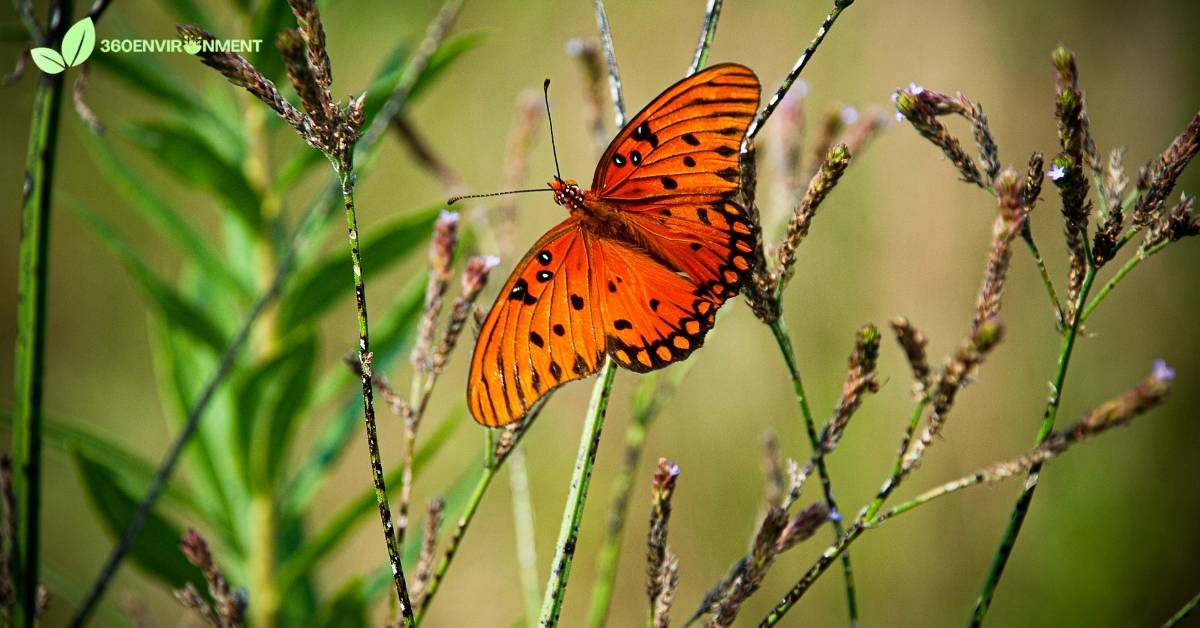Orange butterflies are among the most visually striking and ecologically significant insects in the natural world. With their brilliant orange wings, these butterflies can be found in a variety of habitats, ranging from tropical rainforests to temperate meadows and gardens. Their vibrant color is more than just a decorative trait—orange butterflies play key roles in pollination, food webs, and ecosystem health.
In this article, we will delve into the environmental niche of orange butterflies, examining their habitat preferences, feeding behaviors, ecological interactions, and the importance of conserving these charismatic insects. By understanding their role in ecosystems, we can better appreciate their contribution to biodiversity and the environmental challenges they face today.
1. Habitat and Geographic Distribution of Orange Butterflies
Orange butterflies are widely distributed across the globe, thriving in diverse habitats that provide access to nectar and host plants. Their adaptability allows them to flourish in a range of environments, including tropical forests, grasslands, temperate woodlands, wetlands, and even urban areas.
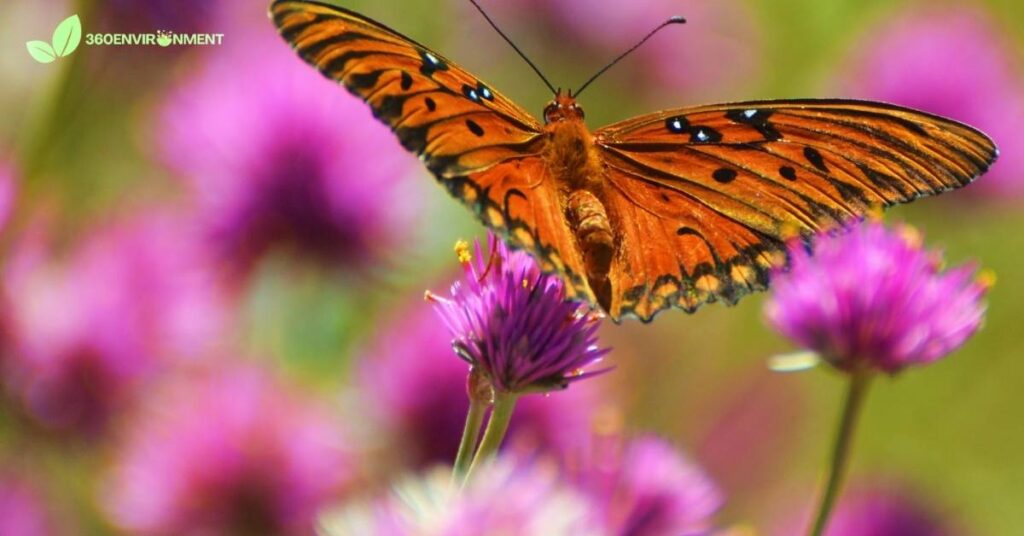
1.1. Tropical Rainforests
Tropical rainforests are home to many species of orange butterflies, where the warm, humid climate and abundant plant life provide ideal conditions for their survival. These ecosystems are some of the most biodiverse on the planet, offering a variety of nectar sources and host plants for butterflies to thrive.
- Julia Butterfly (Dryas iulia): Found in the rainforests of Central and South America, the Julia butterfly is a well-known species with vibrant orange wings. It inhabits lowland forests and is commonly seen near rivers, where its caterpillars feed on passion vine plants.
- Juno Longwing (Dione juno): Another tropical species, the Juno Longwing is native to the forests of Central and South America. This butterfly is often found in open areas of the rainforest, such as clearings and forest edges, where it can find nectar-rich flowers.
1.2. Temperate Woodlands and Meadows
In temperate regions, orange butterflies are commonly found in woodlands, grasslands, and meadows. These habitats offer a rich variety of nectar plants for adult butterflies and host plants for their larvae.
- Monarch Butterfly (Danaus plexippus): Perhaps the most famous orange butterfly, the Monarch is found throughout North America, migrating annually between its breeding grounds in the northern United States and Canada and its overwintering sites in Mexico. Monarchs are often found in meadows, grasslands, and gardens where milkweed, their primary host plant, grows.
- Painted Lady (Vanessa cardui): The Painted Lady butterfly is one of the most widespread species in the world, found on every continent except Antarctica. Its orange and black wings make it easily recognizable in temperate regions, where it inhabits gardens, fields, and open woodlands.
1.3. Wetlands and Riparian Zones
Wetlands and riparian zones—areas near rivers, lakes, and streams—are also important habitats for many species of orange butterflies. These areas provide an abundance of moisture, which supports the growth of nectar-producing plants and the lush vegetation needed for butterfly larvae to feed and develop.
- Gulf Fritillary (Agraulis vanillae): This orange butterfly is commonly found in wetland areas and along waterways in the southern United States, Central America, and South America. Its caterpillars feed on passionflower vines, which are often found in moist, lowland habitats.
- Great Spangled Fritillary (Speyeria cybele): In temperate North America, the Great Spangled Fritillary is often seen near wetlands and along forest edges. Its larvae feed on violet plants, which grow in the moist soils of these habitats.
1.4. Urban Gardens and Parks
While orange butterflies are often associated with natural environments, many species have adapted to urban settings, where they find food and shelter in gardens, parks, and roadside verges. Urban green spaces can serve as important habitats for butterflies, providing them with nectar sources and host plants amidst the human-dominated landscape.
- Small Copper (Lycaena phlaeas): The Small Copper butterfly is a common sight in gardens and urban parks throughout Europe, Asia, and North America. It is attracted to flower gardens where it can feed on nectar from various flowering plants, while its larvae feed on sorrel and dock plants.
2. Adaptations of Orange Butterflies
Orange butterflies exhibit a range of adaptations that help them survive and thrive in their environments. These adaptations include their bright coloration, specialized feeding behaviors, and unique life cycle strategies, all of which contribute to their success as a species.
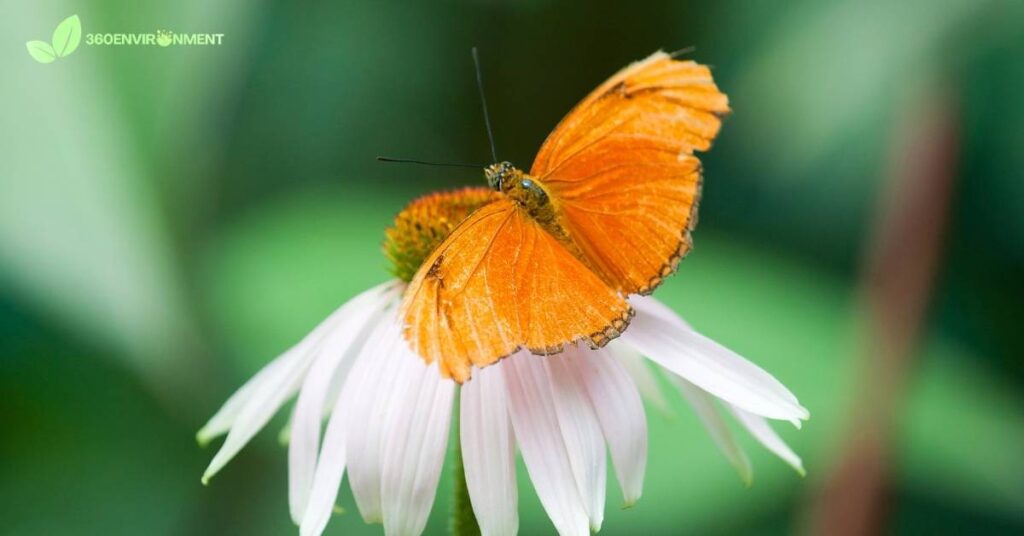
2.1. The Function of Orange Coloration
The vibrant orange coloration seen in many butterfly species serves several ecological purposes, ranging from predator deterrence to mate attraction. The evolution of orange pigmentation in butterflies is often driven by natural and sexual selection, making it a key adaptation for survival and reproduction.
- Warning Coloration (Aposematism): In many orange butterfly species, bright colors serve as a warning to predators. Known as aposematism, this adaptation signals to predators that the butterfly is toxic or distasteful. For example, Monarch butterflies are toxic to birds due to the presence of cardiac glycosides in their bodies, which they obtain from feeding on milkweed as caterpillars.
- Mimicry: Some non-toxic orange butterflies, such as the Viceroy butterfly (Limenitis archippus), have evolved to mimic the coloration of toxic species like the Monarch. This form of Batesian mimicry allows them to avoid predation by resembling species that are harmful to predators, even though they are harmless themselves.
2.2. Feeding Adaptations
Orange butterflies are primarily nectar feeders, using their long, coiled proboscis to extract nectar from flowers. However, their feeding behavior and plant preferences can vary between species, depending on their habitat and the availability of food sources.
- Nectar Feeding: Adult orange butterflies rely on nectar from a variety of flowering plants for sustenance. They are attracted to brightly colored flowers, particularly those in shades of red, orange, and yellow, which provide them with the sugars needed for energy. Some butterflies, like the Painted Lady, are known to travel great distances in search of suitable nectar sources.
- Mud-Puddling Behavior: In addition to nectar, many species of orange butterflies engage in a behavior known as “mud-puddling.” This involves gathering at moist patches of soil, mud, or puddles to drink water and absorb nutrients, particularly salts and minerals that are essential for reproduction. Male butterflies are especially prone to mud-puddling, as the minerals they acquire are transferred to females during mating.
2.3. Life Cycle Strategies
The life cycle of orange butterflies, like most butterflies, involves four stages: egg, larva (caterpillar), pupa (chrysalis), and adult. Each stage is finely tuned to ensure the survival of the species in its particular habitat.
- Egg-Laying and Host Plant Selection: Female orange butterflies are selective when it comes to laying their eggs, often choosing specific host plants that will provide the best food for their larvae. For example, Monarch butterflies lay their eggs exclusively on milkweed plants, while Gulf Fritillaries prefer passionflower vines. This careful selection ensures that the caterpillars will have an adequate food source upon hatching.
- Larval Feeding: The caterpillars of orange butterflies are voracious feeders, consuming large amounts of foliage to fuel their growth and development. Many species have specialized relationships with specific host plants, and their feeding habits can influence the composition of plant communities in their habitats.
3. Ecological Role of Orange Butterflies
Orange butterflies play several important roles in the ecosystems they inhabit. As pollinators, herbivores, and prey, they contribute to the balance and health of their environments. Understanding these ecological roles is key to appreciating the full impact of orange butterflies on biodiversity and ecosystem function.
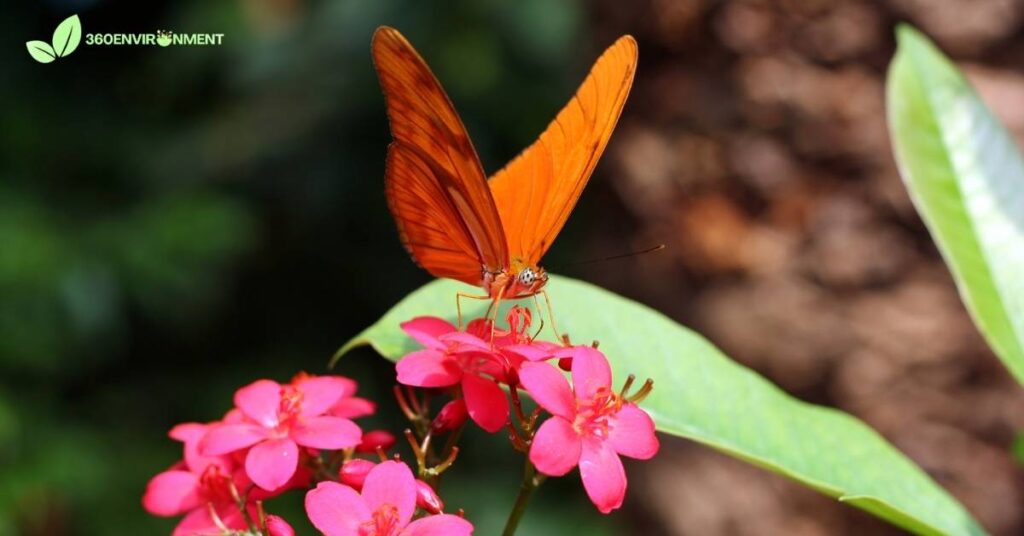
3.1. Pollination and Plant Reproduction
Many species of orange butterflies are important pollinators, visiting flowers to feed on nectar and inadvertently transferring pollen between plants. This pollination service is crucial for the reproduction of many flowering plants, especially in natural habitats such as meadows, forests, and wetlands.
- Butterfly Pollinators: Unlike bees, which tend to focus on specific plants, butterflies are more generalist pollinators, visiting a wide variety of flower species. Orange butterflies, such as the Monarch and Julia, are attracted to brightly colored, nectar-rich flowers like milkweed, lantana, and zinnia. As they move from flower to flower, they transfer pollen, facilitating the reproduction of these plants.
- Cross-Pollination and Genetic Diversity: By promoting cross-pollination between individual plants, butterflies help maintain genetic diversity within plant populations. This diversity is essential for the long-term survival and resilience of plant species, particularly in the face of environmental stressors like climate change.
3.2. Caterpillars and Host Plant Dynamics
The caterpillars of orange butterflies are herbivores, feeding on the leaves of their host plants. While this feeding behavior can have negative impacts on individual plants, it also plays a role in regulating plant populations and maintaining ecosystem balance.
- Herbivory and Plant Population Control: Caterpillars of orange butterflies, such as Monarchs and Gulf Fritillaries, can consume significant amounts of foliage, which can reduce the vigor of host plants. However, this herbivory also helps control the growth of certain plant species, preventing them from becoming too dominant in the ecosystem. This dynamic helps maintain plant diversity in habitats like grasslands and meadows.
- Specialist vs. Generalist Feeding: Some orange butterflies are specialists, meaning their larvae feed exclusively on one or a few plant species. Monarch caterpillars, for example, are specialists on milkweed. Other species, like the Painted Lady, are generalists, with larvae that feed on a wide range of plants, giving them greater flexibility in terms of habitat and food availability.
3.3. Predators and Food Web Interactions
Orange butterflies are an important food source for a variety of predators, including birds, spiders, and other insects. While their bright coloration and chemical defenses can help deter some predators, they are still vulnerable at various stages of their life cycle, especially during the egg and larval stages.
- Bird Predators: Birds are among the primary predators of adult butterflies. While the bright orange coloration of species like the Monarch can warn predators of toxicity, some bird species, such as orioles and grosbeaks, have developed strategies to eat only the non-toxic parts of the butterfly.
- Parasites and Predators of Caterpillars: Caterpillars are particularly vulnerable to predation and parasitism. Parasitic wasps and flies often target butterfly larvae, laying their eggs inside the caterpillars. Once the parasitic larvae hatch, they consume the caterpillar from within. This natural control mechanism helps regulate butterfly populations and prevents them from becoming too numerous.
4. Conservation of Orange Butterflies
Orange butterflies face a variety of threats, including habitat loss, climate change, and the widespread use of pesticides. Conservation efforts are essential for protecting these insects and ensuring their continued role in ecosystems. By focusing on habitat restoration, reducing pesticide use, and promoting public awareness, we can help conserve orange butterflies for future generations.

4.1. Habitat Loss and Fragmentation
The destruction of natural habitats is one of the most significant threats to orange butterflies. Many species rely on specific plants and ecosystems for survival, and when these habitats are lost to agriculture, urban development, or deforestation, butterfly populations can decline dramatically.
- Monarch Habitat Loss: Monarch butterflies have experienced severe habitat loss in both their breeding and overwintering ranges. The conversion of grasslands to agriculture has reduced the availability of milkweed, while deforestation in Mexico threatens their overwintering sites. Conservation efforts to protect these habitats are critical for the survival of the Monarch migration.
- Urbanization and Fragmentation: In temperate regions, urban sprawl and road construction fragment butterfly habitats, making it difficult for species like the Painted Lady to find suitable places to feed, breed, and lay eggs. Creating green corridors and butterfly-friendly urban spaces can help mitigate these effects.
4.2. Pesticides and Chemical Pollution
The widespread use of pesticides in agriculture and landscaping poses a major threat to orange butterflies. These chemicals can kill butterflies directly or reduce the availability of nectar and host plants, leading to population declines.
- Impact of Neonicotinoids: Neonicotinoid pesticides, in particular, have been shown to be harmful to pollinators, including butterflies. These chemicals can impair butterflies’ ability to navigate, feed, and reproduce. Reducing the use of harmful pesticides and promoting organic farming practices are essential for butterfly conservation.
- Herbicide Use and Milkweed Decline: The use of herbicides in agriculture has significantly reduced the availability of milkweed, the primary host plant for Monarch caterpillars. Without milkweed, Monarch populations cannot survive. Conservation efforts to plant milkweed in gardens, parks, and along roadsides are helping to restore critical habitat for these butterflies.
4.3. Climate Change and Its Effects on Orange Butterflies
Climate change is expected to have wide-ranging impacts on butterfly species, including orange butterflies. Changes in temperature, precipitation patterns, and the timing of plant blooming could disrupt the life cycles of these insects, making it more difficult for them to survive and reproduce.
- Range Shifts: As temperatures rise, some species of orange butterflies may be forced to shift their ranges to cooler, higher elevations or latitudes. This could lead to the loss of populations in certain areas while new populations establish themselves in previously unsuitable habitats.
- Phenological Mismatches: Climate change could also cause phenological mismatches, where the timing of butterfly emergence no longer aligns with the availability of host plants or nectar sources. This could result in reduced survival rates for both caterpillars and adult butterflies.
5. Promoting Orange Butterfly Conservation
Conserving orange butterflies requires a multi-faceted approach that includes habitat restoration, protection of natural areas, and public education. By creating butterfly-friendly habitats and reducing the use of harmful chemicals, we can help ensure the survival of these beautiful insects.
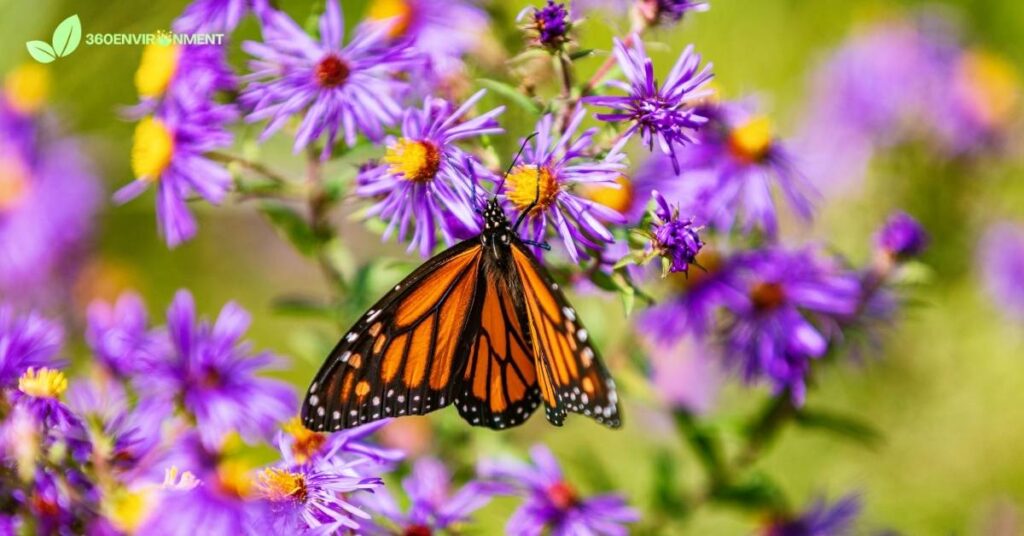
5.1. Creating Butterfly-Friendly Habitats
Restoring natural habitats and creating butterfly-friendly gardens and parks can provide orange butterflies with the resources they need to survive. Planting native host plants and nectar-rich flowers is one of the best ways to support butterfly populations.
- Pollinator Gardens: Planting butterfly-friendly flowers, such as milkweed, asters, and coneflowers, can provide important food sources for orange butterflies. Ensuring a diversity of plant species that bloom throughout the growing season can help sustain butterflies from spring to fall.
- Restoring Native Plants: In natural areas, efforts to restore native plant communities can help support the host plants that orange butterflies rely on. In particular, planting species that are important for butterfly larvae, such as milkweed for Monarch caterpillars, can boost local butterfly populations.
5.2. Reducing Pesticide Use
Limiting the use of harmful pesticides and promoting organic farming practices can help protect orange butterflies and other pollinators from chemical exposure.
- Integrated Pest Management (IPM): Farmers and gardeners can use integrated pest management strategies to reduce the need for chemical pesticides. IPM practices include monitoring pest populations, using biological controls, and applying pesticides only when absolutely necessary.
- Organic Farming: Organic farming practices, which avoid the use of synthetic pesticides and fertilizers, can help create a healthier environment for butterflies and other pollinators.
Conclusion: The Ecological Importance of Orange Butterflies
Orange butterflies are more than just vibrant and beautiful insects. They play a crucial role in pollination, plant interactions, and maintaining the balance of ecosystems. As pollinators, herbivores, and prey, they are integral to the health of the environments they inhabit. However, these butterflies face significant challenges from habitat loss, climate change, and pesticide use, making their conservation a priority.
By understanding the environmental niche of orange butterflies and taking steps to protect their habitats, we can help ensure the survival of these striking insects for future generations. Whether through habitat restoration, promoting butterfly-friendly gardening practices, or reducing pesticide use, we can all play a role in conserving orange butterflies and the ecosystems they support.
Read More: The Yellow Monarch Butterfly: An Environmental Perspective

